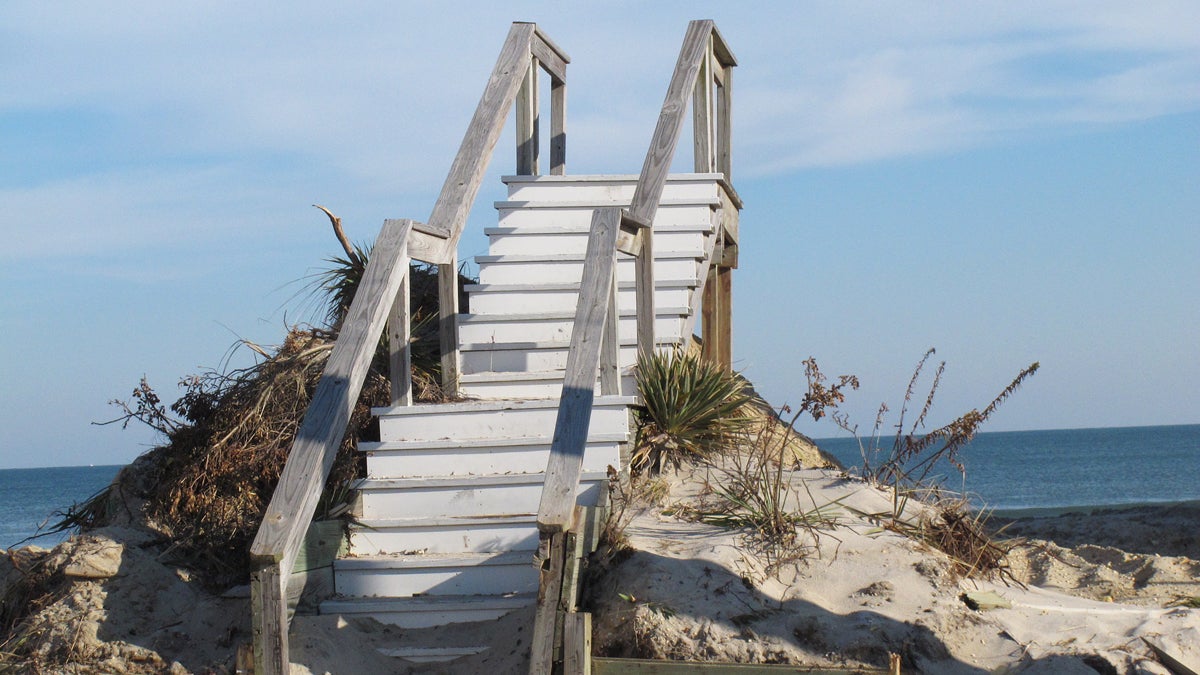Post-Sandy recovery: Balancing regional planning and home rule

In this Nov. 29, 2012, photo, a stairway to nowhere sits on what is left of the beachfront in Toms River, N.J. (AP Photo/Wayne Parry)
This is the second in a two-part article detailing the issues that planners and advocates are grappling with as they struggle to restore and remake the Jersey Shore. An online conversation is also available that lets you discuss challenges and strategies with some of these experts. NJ Spotlight partner WNYC/NJPR contributed to this article.
Toms River Township Planner Jay Lynch likes to show visitors his framed certificate from the American Institute of Certified Planners that’s hanging on a wall in the corner of his office. It’s Professional Planner license No.19, which he claims is the lowest number still practicing in the state. His co-workers sometimes tease him that this means he’s really old, but he sees it as a badge of honor, a testament to his wealth of experience.
Over the past 50 years, Lynch says he’s heard the growing calls by environmentalists for people and development to move away from the most vulnerable areas of the coast, places like Seaside Heights, Mantoloking and Ortley Beach. Those calls have intensified in the aftermath of Sandy, but Lynch sees them as premature. “I think it’s too early to retreat. It’s too early to bail out,” he said. “I’m not sure whether anybody could even figure out an economic solution to retreating at this point. There’s a lot of property value out there, and you can’t just tell people they can’t use their property. You can’t deny building permits unless you compensate. I don’t think, pragmatically, that there’s a way to do a strategic retreat.”
But it isn’t simply a question of retreat or restore. What decisions are made and where they are made are among the thorniest issues facing planners looking to reinvent the shore. New Jersey has a strong tradition of “home rule,” in which communities decide key issues for themselves. It may help explain why the concept of shared services never really caught on.
But thinking locally can be particularly problematic post-Sandy, since one town’s plan of action may not jibe with a neighbor’s. One of the most notable examples of this is Hoboken’s plan to build a seawall to redirect storm surge. Unfortunately, the redirected water may flood nearby towns.
What’s more, weather patterns are regional rather than local, as several planners point out. But what it will take to move local New Jersey officials to take a broader—or more holistic—view of the Sandy-scarred beaches and boardwalks is still an open question.
Meanwhile, there’s a growing sense among a number of environmentalists that whatever choice is made will be the wrong one. For them, Federal Emergency Management Agency maps and dune replenishment—even if executed along the full length of shore—will prove inadequate because the guidelines themselves are inadequate and don’t take into account the effect of global warming.
Growing too fast
Historically, Ocean County—where Toms River is located—has been the fastest growing county in the state. Between 1950 and 2010, its population increased tenfold, and growth along the Jersey Shore overall has more than tripled in that time, though census data shows that trend has slowed over the past few years in the wake of the housing bubble. This growth has been an essential part of the state’s economy, but it’s also the reason New Jersey’s losses in the storm totaled $37 billion.
Many policy experts in the fields of planning and the environment think Sandy was a wake-up call, a sign that we’ve been moving too fast along the coast and warning us that we need to alter our patterns of development if we hope to make the shore more resilient to future events like Sandy. They say that leaving important planning decisions to local municipalities is the wrong approach, since towns are highly dependent on property tax revenue and often have a strong incentive to pursue redevelopment, even in areas where it might be best not to rebuild.
And they’re concerned that with federal money being used for the reconstruction, more oversight is needed to ensure that taxpayers aren’t subsidizing risky development that might be washed away again in the next storm. At the same time, state officials have been hesitant to micromanage the storm’s aftermath. They fear that intruding too much in local planning decisions could add red tape to the recovery process, slowing things down and usurping the rights of individual shore communities and residents to determine their own futures.
*** More ***
WHYY is your source for fact-based, in-depth journalism and information. As a nonprofit organization, we rely on financial support from readers like you. Please give today.




